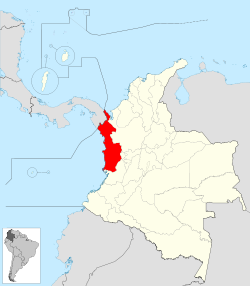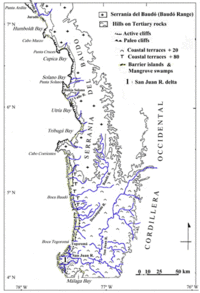- Chocó Department
-
Department of Chocó
Departamento de Chocó— Department — 
Flag
Coat of armsChocó shown in red Coordinates: 5°42′N 76°40′W / 5.7°N 76.667°WCoordinates: 5°42′N 76°40′W / 5.7°N 76.667°W Country  Colombia
ColombiaRegion Pacific Region Established November 3, 1947 Capital Quibdó Government - Governor interim (Appointment) Area - Total 46,530 km2 (17,965.3 sq mi) Area rank 9 Population (2005)[1] - Total 441,395 - Rank 23 - Density 9.5/km2 (24.6/sq mi) Time zone UTC-05 ISO 3166 code CO-CHO Provinces Municipalities 30 Chocó is a department of Colombia known for its large Afro-Colombian population. It is in the west of the country, and is the only Colombian department to have coastlines on both the Pacific Ocean and the Atlantic Ocean. It also has all of Colombia's border with Panama. Its capital is Quibdó.
Chocó has a diverse geography, unique ecosystems and unexploited natural resources. However, its population has one of the lowest standards of living of all Departments in Colombia. In March 2007 Colombian media reported that some 50 children starved in less than three months, creating awareness of the grave condition Chocó inhabitants are facing. Infrastructure problems were also revealed. For example, despite its status as the world's rainiest lowland, with close to 400 inches of annual precipitation,[2] Chocó's capital Quibdó was left without water.[3]
Contents
History
The Department was created in 1944 but it was never legally established.[3] Due to its low population, inhospitable topography, and distance from Bogotá, Chocó has received little attention from the Colombian government. During the government of military dictator Gustavo Rojas Pinilla Chocó was to be eliminated as a department and divided between Antioquia Department and Valle del Cauca Department, but Pinilla's intentions were thwarted by the 1957 coup d'etat of General Gabriel París Gordillo.
Armed conflict
Main article: Colombian armed conflict (1960s–present)Until 1993 Chocó was relatively peaceful. However, with the coming of the Popular Liberation Army (ELN by its Spanish initials) there ensued a three-way struggle between the national military, the incoming guerrillas and local paramilitaries, with the serious consequence of massive population displacement. By 1997, although the military did not control much of the department, the internal Autodefensas Unidas Campesinas (Farmers United for Self-Defence) controlled about 75% of the territory.
On May 2, 2002, in the town of Bojayá (with its urban centre also referred to as Bellavista), FARC guerrillas seized the town in an attempt to take control of the Atrato River region from AUC paramilitaries, in the process killing approximately 119 civilians in an apparently indiscriminate attack with improvised homemade mortars assembled with gas cylinders parts (known in Spanish as pipeta or Cilindro bomba). This became known as the Bojayá massacre.
Armed conflict 2008-2011
The armed conflict in Chocó has seen an escalation after the northern part of the department became a hotbead of coca cultivation in 2008. Many new paramilitary groups have emerged after the demobilisazion of AUC, while guerrillas like FARC and ELN have regained ground in many parts of the department. According to some estimates more than 50,000 civilians have become internal refugees due to the fighting between guerrillas, neo-paramilitaries, the army and drugraffickers between 2008 and 2011.[4]
Geography
The Chocó Department makes up most of the ecoregion known as El Chocó that extends from Panama to Ecuador.
The municipality of Lloró holds the Highest Average Annual Precipitation record measured at 523.6 inches (13,300 mm) which makes it the wettest place in the world.[5] Three large rivers drain the Chocó Department, the Atrato, the San Juan and the Baudó, and each has many tributaries. The Baudó Mountains on the coast and the Cordillera Occidental are cut by low valleys with an altitude less than 1,000 meters that form most of the territory. Most of the Chocó is thick rain forest. Much of Colombia's internal consumption of wood come from the Chocó, with a small percentage harvested for export.
Demographics
Chocó is inhabited predominantly by descendants of African slaves brought by the Spanish Colonizers after conquering the Americas. The second race/ethnic group are the Emberá, the remaining Native American people, with more than half of their total population in Colombia living in Chocó, some 35,500. They practice hunting and artisan fishing and live near rivers.[6]
The total population as of 2005 was less than half a million, with more than half living in the Quibdó valley.
Towns and municipalities
Quibdó is the largest city with a population of almost 100,000. Other important cities and towns include Istmina, Condoto, Nóvita and El Carmen in the interior, Acandí on the Caribbean coast, and Solano on the Pacific coast. Resorts include Capurgana on the Caribbean coast, and Jurado, Nuquí, and Bahía Solano on the west coast.
Municipalities
- Acandí
- Alto Baudó
- Atrato
- Bagadó
- Bahía Solano
- Bajo Baudó
- Belén de Bajirá
- Bojayá
- Carmen del Darién
- Cértegui
- Condoto
- El Cantón de San Pablo
- El Carmen de Atrato
- Istmina
- Juradó
- Litoral del San Juán
- Lloró
- Medio Atrato
- Medio Baudó
- Medio San Juán
- Nóvita
- Nuquí
- Quibdó
- Río Iró
- Río Quito
- Riosucio
- San José del Palmar
- Sipí
- Tadó
- Unguía
- Unión Panamericana
See also
References
- (Spanish) todacolombia.com - Chocó Department
Notes
- ^ Resultados censo général 2005: Chocó
- ^ James J. Parsons (November 1978), "Review of Slavery on the Spanish Frontier: The Colombian Chocó, 1680-1810 by William Frederick Sharp", The Hispanic American Historical Review (Duke University Press) 58 (4): 717–718, http://www.jstor.org/stable/2513352, retrieved 2010-02-07
- ^ a b "¿Se debe acabar Chocó?" (in Spanish). Semana (Bogotá: Semana.com). 31 March 2007. http://www.semana.com/wf_InfoArticulo.aspx?IdArt=101935. Retrieved 7 February 2010.
- ^ http://www.internal-displacement.org/countries/colombia
- ^ NOAA Satellite and Information Service Global Measured Extremes of Temperature and Precipitation
- ^ "86 tribus subsisten en Colombia" (in Spanish). El País (Cali, Colombia: elpais.com). 23 March 2007. http://www.elpais.com.co/historico/mar232007/NAL/tribus.html. Retrieved 7 February 2010.[dead link]
External links
- Mosquera-Machados, Silvia del Carmen (2002) "Cadre général du département du Choco" in Analyse multi-aléas et risques naturels dans le département du Chocó (nord-ouest de la Colombie) Université de Genève, Geneva in French
- "Mision de Observacion a la Situación de las Comunidades Afrodescendientes en Colombia: Anexo 1" in Spanish;
- Choco 7 dias - local newspaper founded by Elacio Murillo, former member of the Choco state assembly who was assassinated by armed gunmen on January 12, 2007.
- Alternative Development, Economic Interests and Paramilitaries in Uraba, TNI Drug Policy Briefing No 27, September 2008. By Moritz Tenthoff
Departments of Colombia  Categories:
Categories:- Chocó Department
- Departments of Colombia
- States and territories established in 1947
Wikimedia Foundation. 2010.


